How to Lay Tile
Last Updated: 08/02/2019
A Detailed Guide to Floor Installation
So, you’re ready to learn how to tile? Great! While this resource is by no means a fully exhaustive tutorial, it is an overview of the process from beginning to end. After reading this, you should have a good grasp of what tools and supplies you’ll need and an overview of the process from planning to grouting.
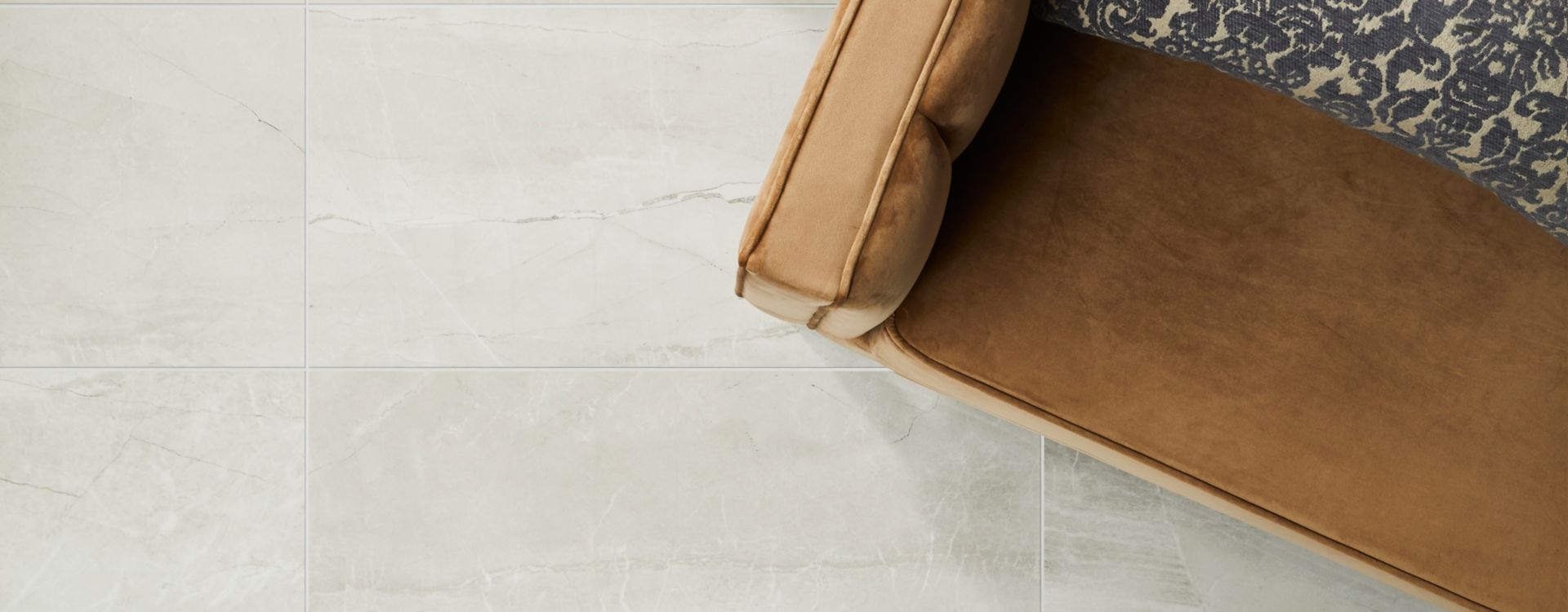
Throughout this guide, you’ll note that sometimes we’ll guide you to check the manufacturer’s recommendations for your specific product or with a store associate. This is because of the wide variety of different products and materials available that can have unique specifications. Our store associates are tile experts and they know the products best, so they are always a reliable resource to guide you in the right direction and point you toward the building codes for your area. If you have additional questions, refer to our FAQs or other resource articles for more.
Let's get started!
Tools & Materials
Refer to our convenient installation checklist to make sure you have considered all the tools and materials you may need for each step of your installation. The basic items you will need to install tile are listed below.
- Underlayment is something you put on top of your substrate to prepare it for tiling. The substrate (or subfloor) is the ground, whether it’s made of plywood or cement.
- Cement board or backer board are the most standard underlayments. They come in various thicknesses for different spaces. You will need to tape the joints for this type of underlayment.
- Membrane is typically a fiberglass composite material that is used for preventing deflection (bending and flex in floor) and decoupling (separation or sliding of a joint). You will need to tape the joints for this type of underlayment.
- Waterproof underlayments are necessary for wet areas. Your options are a paint-on application, a membrane or a waterproofing backer board. You will need to tape the joints for this type of underlayment.
- Self-leveling cement may be needed to help level an uneven floor or protect heating wires. This product uses a primer and a cement.
- Mudset is a combination of Portland cement and sand.
- Adhesives
- Epoxy is both an adhesive and a grout. The adhesive is used for stone with resin backing.
- Thinset can refer to cement mortar or thinset mortar. Cement mortar is a mixture of sand, Portland cement and water. Thinset mortar is a mixture of Portland cement, fine sand and a water-retaining agent or activator. Refer to our thinset recommendation chart to determine the best one for your space.
- Premixed adhesives eliminate measuring and mixing, so you can start installing faster, but they may have some limitations on how and where they can be used. Make sure to completely read the label before installing your tile.
- Mastic is a premixed glue that can only be used in dry areas. If it gets wet, it won’t fully cure, and the product will release. This is a good do-it-yourself option because it is easy to use and premixed.
- The grout you will need depends on the type of tile you are using and the space.
- Epoxy is both an adhesive and a grout. The adhesive is used for stone with resin backing.
- Sanded grout has small sand particles in it and is a baseline adhesive for many tiles.
- Unsanded grout does not contain sand particles and is used with glass, polished stone and smaller grout joints.
- Excel grout contains sand particles but can still be used in smaller grout joints because the aggregate is smaller.
- Premixed and single-component grouts are also available. These eliminate the step of mixing your own grout.
- A sealer may or may not be applied. Check to see if your tile or grout will need to be sealed.
- Stone sealers
- Natural sealers give a dry look.
- Enhance and seal gives a wet look.
- Grout sealers
- Stone sealers
- Tools
- Trowel: Selecting the right trowel is an important consideration and depends on the size of the tile. Refer to this checklist to determine the best trowel size and shape for your project.
- Tip: A margin trowel (also known as a tiler’s best friend) is a very useful tool to have. It can be used for mixing, cleaning squeeze out from grout lines and popping a tile out of thinset to check coverage.
- Float (for grouting)
- Cutting tool (either a wet saw or scoring snap cutter)
- Spacers: Depending on your space, choose from wedges, T spacers or leveling spacers.
- Buckets
- Sponges
- Tape
- Utility knife
- For full list of tools and supplies and recommendations, talk to your store associate.
- Trowel: Selecting the right trowel is an important consideration and depends on the size of the tile. Refer to this checklist to determine the best trowel size and shape for your project.
Before You Begin
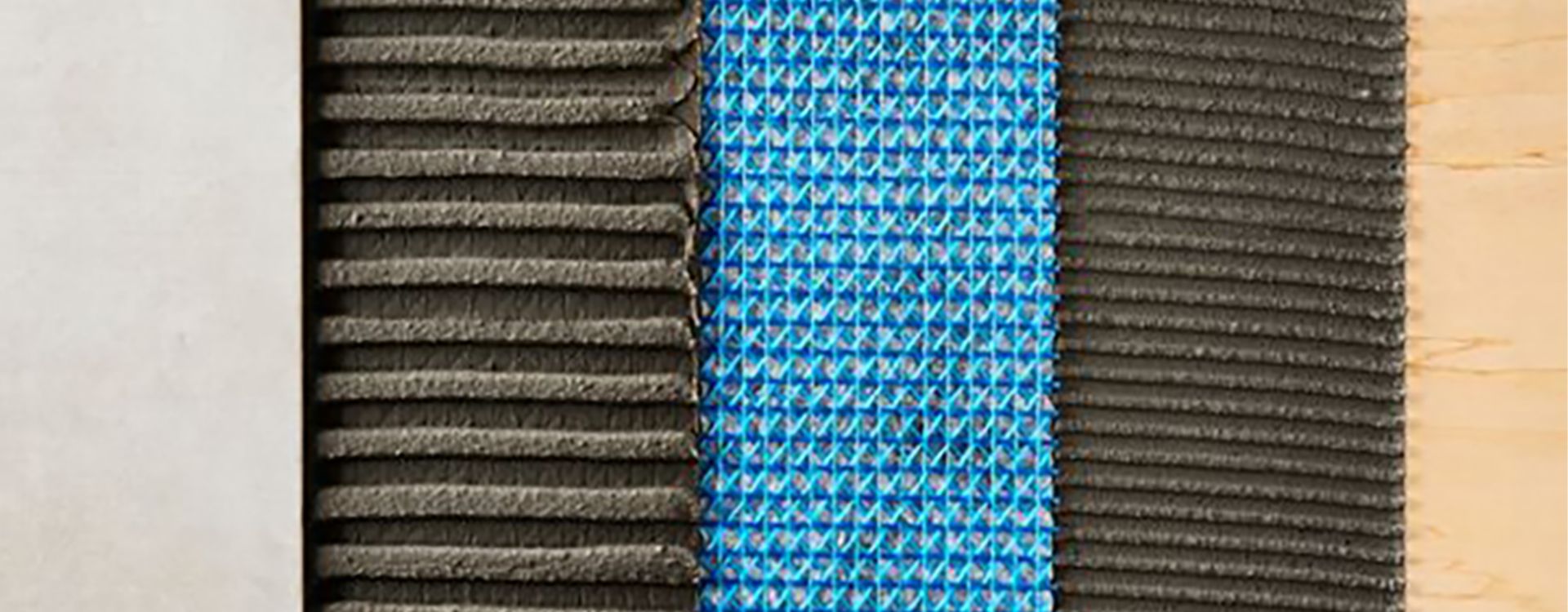
It’s important to make sure you have the right surface prepared before you think about beginning to tile. Ask yourself what your existing subfloor is and what the adjoining floor height is. This will help you determine and narrow down which underlayment to use. This is also the time to decide whether or not you want to include heating under your tile. Once you have weighed all of these factors, you can choose the right underlayment for your space. Next, make sure the floor’s surface is clean, dry, swept or vacuumed and free of dust before you install your underlayment.
Planning Your Layout

Planning Your Layout
As the saying goes, measure twice, and cut once. Putting in the time to plan your layout before you begin will always be worth it in the long run and will make your installation look even better.
Once you have all the tools and materials you need, the next step is to start planning the layout of your design. This is an important step because once you start installing tile, it’s hard to go back and rethink the layout.
First, find the center of the room. The easiest way to do this is to measure the length of one wall and divide that number in half. Then, measure the opposite wall and divide that number in half. Snap a line on the floor connecting the two center points. Do the same thing with the other two walls, and snap a line. You have two lines that intersect at the center point of the room. Start dry laying (placing tiles on the ground without adhesive purely to plan the layout) a row of tiles (including spacers) out in one direction from the center point. Make sure that you will not end up with a sliver cut (defined as less than half of a tile) at the end. If you will end up with less than a half of a tile, shift the layout starting point to adjust. Just because you start planning the layout from the center does not mean the tile has to start in the exact center of the room. Do the same in the direction 90° from the last row to ensure there are no sliver cuts in that direction either. Make sure to account for any design features you are incorporating during this step, such as diagonal tile, a unique pattern or tiled border.
Now that you know how your layout is going to look, plan out the order you will tile around the room, quadrant by quadrant, so you end in front of a door and don’t get tiled in. If you are tiling walls and floors, we recommend starting with floors so that your wall tile will overlap and sit on top of the floor tile. This ensures that water will run onto the floor tile instead of into the grout joint or under the tile.
Installation
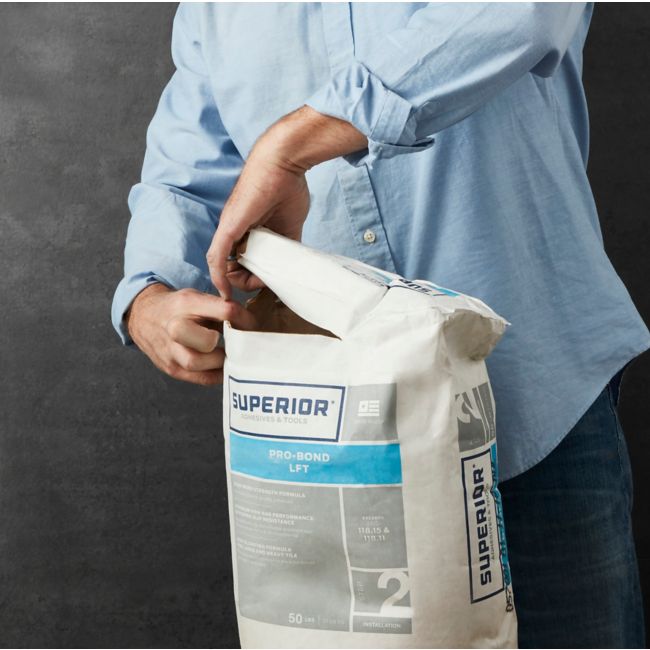
Installation
It’s time for the exciting part! Read on to learn about all the essential steps of installation and hear our expert tips to make it all go smoother.
You’re picked out your tile and gathered the necessary tools and materials. The installation step is where it all comes together, and you begin to see your beautiful design take shape. As in the rest of the process, it’s important to plan ahead to ensure the best possible results. We recommend reading through all of these steps first before you begin. We’ll cover mixing and laying thinset, laying tile and finishing touches like grouting, sealing and caulking.
Mixing Thinset

Mixing Thinset
This step is more important than it may seem. Getting the right consistency and timing for your thinset is vital to a successful installation.
Before you begin mixing and laying thinset, it’s important to know what open time and cure times are. Open time is the amount of time you have to work with your thinset before it hardens. This is also called bucket life. This is typically around 30–40 minutes and can vary by type of thinset, temperature, humidity, etc. To test if your thinset is still within its open time, do the finger test. If you stick your finger into the bucket of thinset and it comes out clean, it’s no longer tacky enough to stick to your tile or underlayment either. Once the thinset is past its open time, it needs to be thrown out, the bucket cleaned out and a new batch started. Cure time is the amount of time it takes for thinset to set up fully once it’s installed. Refer to manufacturer recommendations for cure times.
-
1. Start by adding your liquid to your bucket first. Refer to the manufacturer’s recommendations for the ratio of liquid to powder.
2. Add powder in small batches to avoid clumps and bubbles of unmixed powder.
3. Add enough powder to achieve the recommended consistency. We typically aim for a peanut butter consistency. A good tip is if you can scoop the thinset up with your trowel, turn it on its side and it stays a few seconds before falling into the bucket, it’s the correct consistency.
4. Once you’ve reached the right consistency, let the thinset slake for 5–10 minutes (based on manufacturer’s recommendation). Slaking means letting the thinset sit in the bucket to allow the ingredients to activate and for crystals to form. This step is important to achieve good adhesion.
5. Briefly remix thinset, and check for the correct consistency again.
6. Start by mixing a small amount of thinset before you know how fast you will be working due to the open time (see below).
7. NEVER rinse thinset down the drain when cleaning! This will set in and clog your pipes.
Laying Thinset
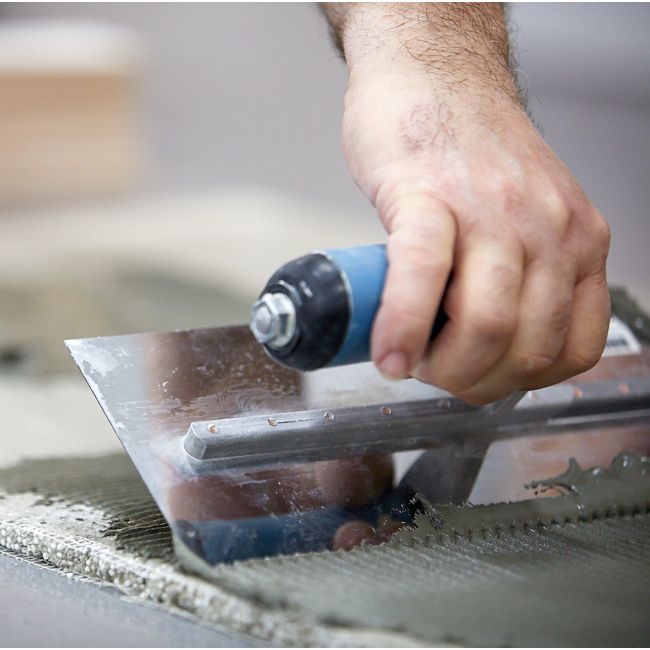
Laying Thinset
Thinset is responsible for keeping your tile attached to your floor—so it’s important to make sure it’s done right! We’ll break down all the steps and pass our expert experience onto you.
Once your thinset is ready, you can begin applying it to the substrate or underlayment with your notched trowel. For large-format tiles, you should also back butter the tile by applying thinset directly to the back of the tile. Your notched trowel will leave grooves on the substrate and/or tile. Make sure these are all running in the same direction to achieve a consistent mortar bed beneath the tile. Hold the trowel at approximately a 45° angle as you spread the thinset to achieve a thick enough layer.
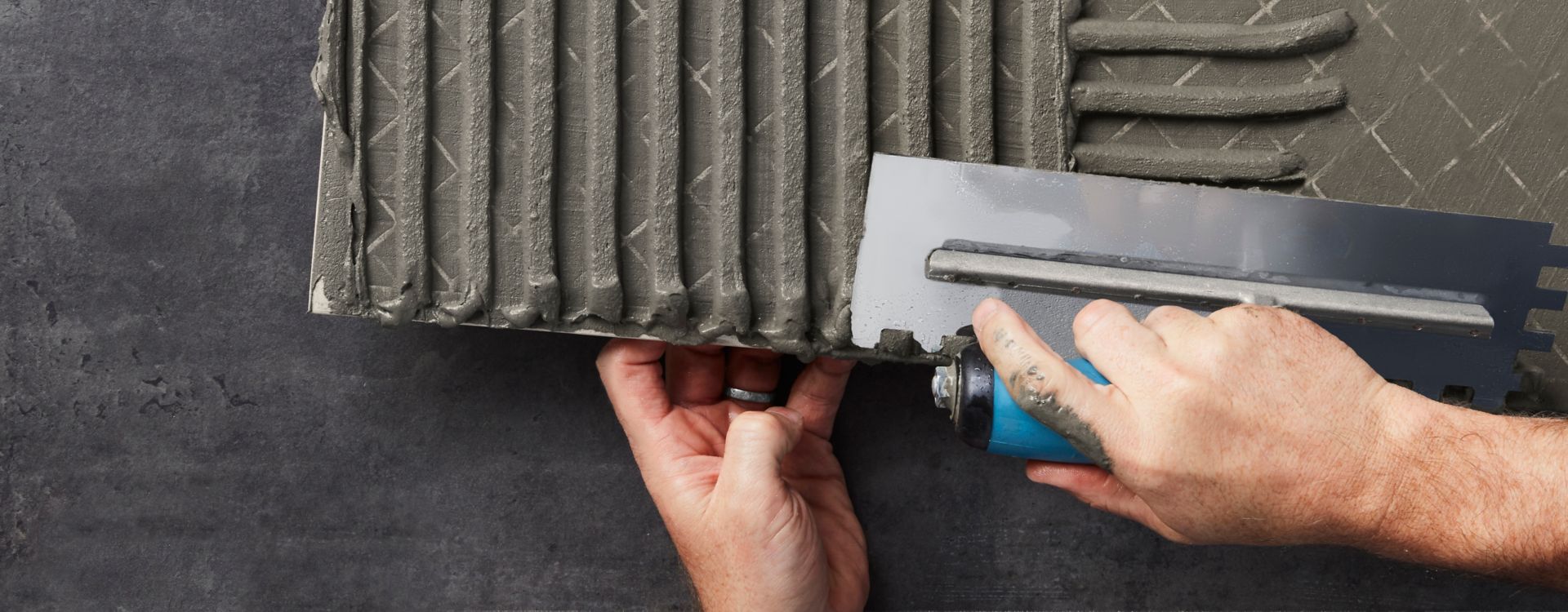
Laying Tile
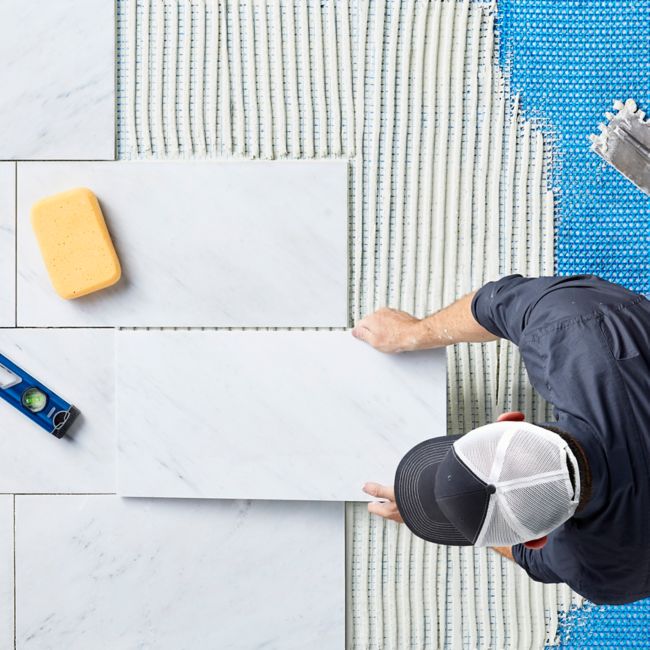
Laying Tile
Your planning, mixing and thinset mixing have all paid off—it’s time to tile! Read our advice in this section to make sure it’s a project that lasts for years.
It’s time to tile! When you set a tile into thinset, apply firm, even pressure. Wiggle the tile back and forth a bit to allow the ridges in the thinset to break down and fill in the valleys. This achieves a solid layer of thinset beneath the tile. After you do this with your first tile, lift it back up, and check to ensure there is 80–90% thinset coverage on the back of the tile. If there is not, recheck consistency of thinset, and make sure the correct size trowel is being used at the correct angle.
Don’t forget to use spacers in between tiles to get a consistent gap and grout lines throughout your installation. The spacers should be able to be removed after the thinset cures. Make sure to clean up any excess thinset on tiles and in between tiles as you go. It’s much easier to clean up when it’s wet. If you pause in your tiling, make sure to also wipe up any thinset on the floor that does not have tile on it. If it is left to dry, it can lead to an uneven surface. Make sure to clean all of your tools at the end of each day so that thinset and grout do not get caked on. Remember not to rinse or dump any thinset down the drain!
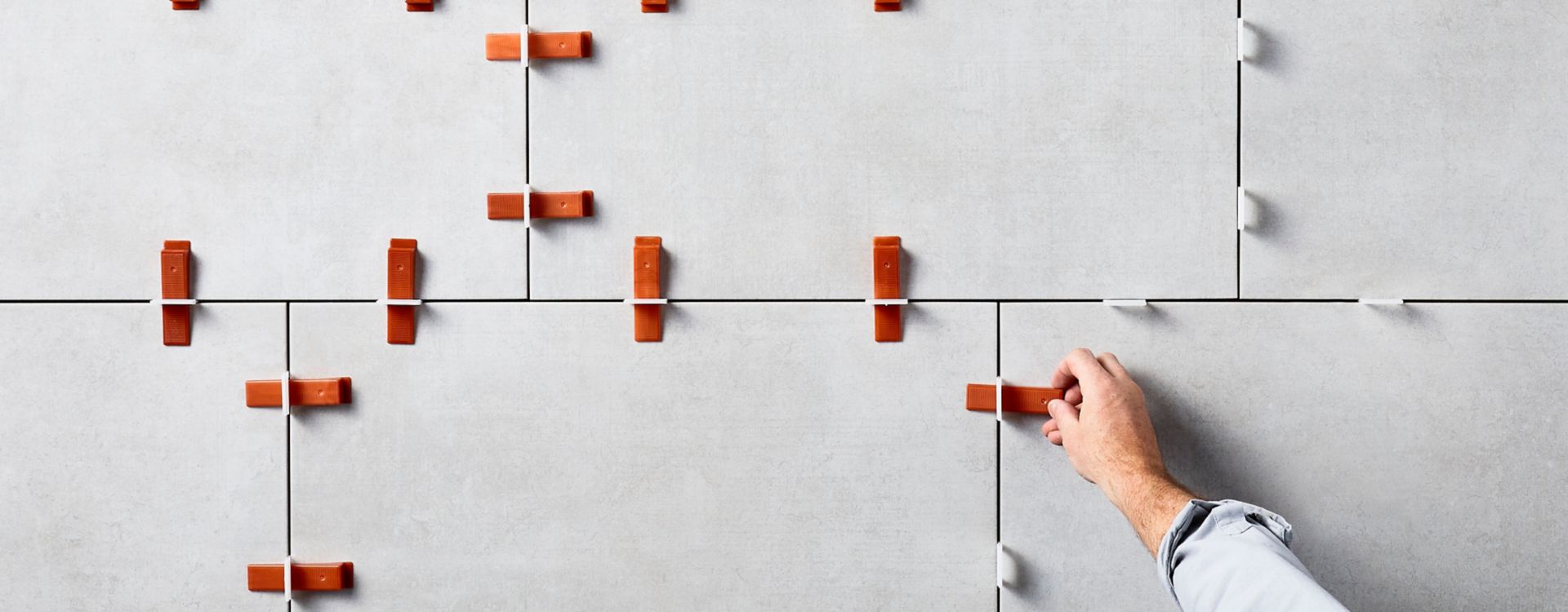
-
• As you reach the edges of the room, you will need to begin cutting tiles to fit. You have two choices for how you want to do this. The first is to tile as much as you can using full tiles, save all of the cuts for the end and let the floor cure. That way you can walk on the floor as you install the edge tiles. Or you can choose to cut and install edge tiles as you go.
• Refer to the manufacturer’s recommended cure time before walking on your tile or beginning to grout.
• Measure the space you need the tile to fit into before you cut, and don’t forget to take the grout joint into account.
• You’ll typically want to leave at least an eighth of an inch where the tile meets the wall to allow for any expansion, contraction or shifting of the house, which is natural. This space will usually be covered up with wall tile or trim and caulked.
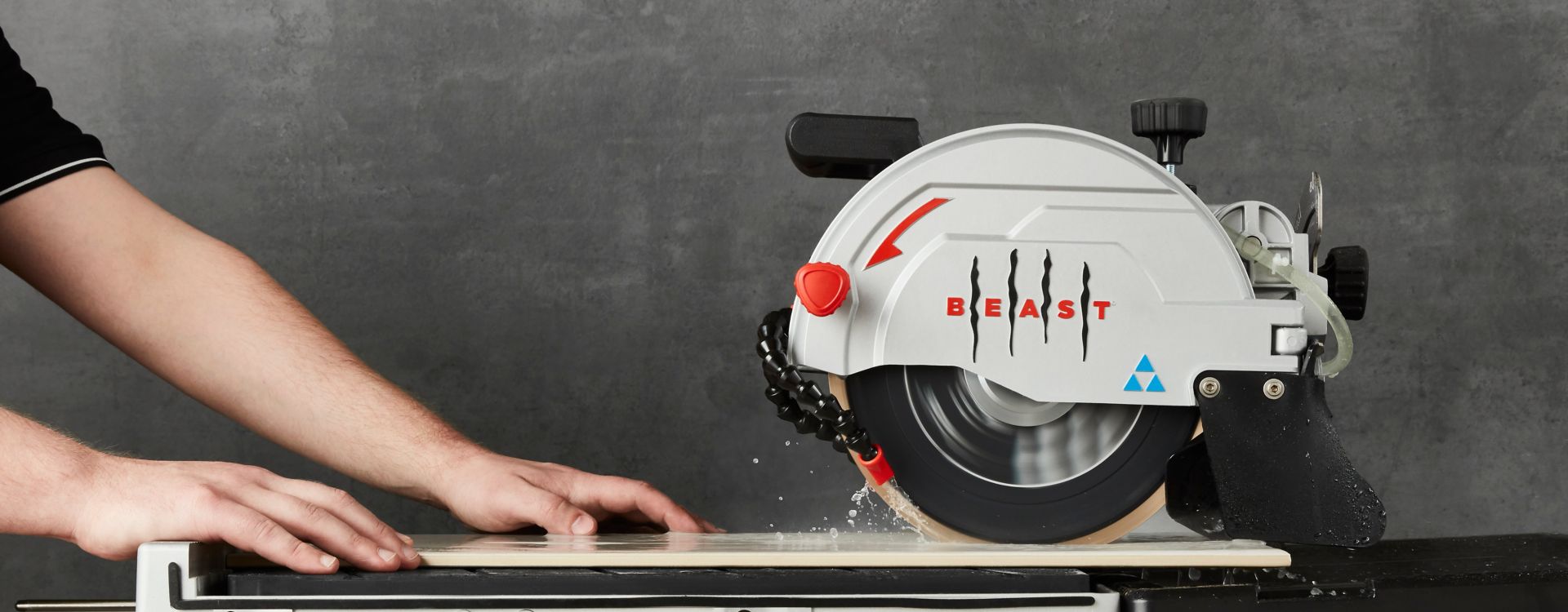
Grouting
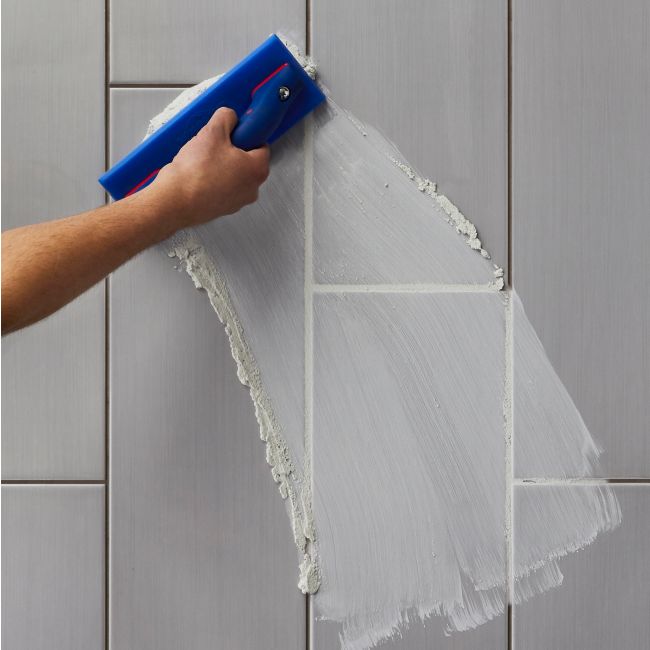
Grouting
Grout is more than just a nice line of color between your tiles. It has the important function of bonding your tile and preventing it from cracking and chipping due to the movement of your home.
Preparing for Grouting
Prepare your space for grouting by cleaning off any excess thinset squeeze out and in grout joints. A utility knife works the best to clean out the grout joints. Make sure to swap out your water bucket regularly, work with clean water and use an almost dry sponge. Then, remove your spacers. If you have installed a man-made tile, such as glass, ceramic or porcelain, now is a good time to apply a grout release. This prevents the grout from sticking excessively to the surface of the tiles. If you are using natural stone or encaustic cement tiles, we recommend also applying a stone sealer before grouting. For particularly heavily textured stones, you can also use a grout release after this step.
Refer to any manufacturer’s recommendations for mixing your specific grout. This step may not be necessary since some grouts come premixed. Add liquid to the bucket first. Next, add powder in batches to avoid clumping. You can usually add more liquid but will tend to run out of powder first, so start mixing small batches first. Mix thoroughly to ensure all grout pigment is incorporated evenly to avoid streaking. Let grout mixture slake according to the manufacturer’s recommendation, and briefly remix before application. Keep open time and cure times in mind as you did for the thinset step.
Have a bucket of water and a sponge on hand to clean as you go. Begin applying your grout with a grout float. A grout float is a flat rubber or silicone tool with a flexible edge, similar to a spatula. Hold it at a 45° angle while also coming at your grout line diagonally. If you apply grout parallel to the joint, it will tend to pull grout out of the joint instead of pushing it in. Make sure to fill in the joint completely from top to bottom. We like to recommend alternating grouting and cleaning and switching back and forth every 10–30 minutes depending on the type of grout, temperature and other factors. That’s why it’s important to figure out the open time. Be careful not to use too much water when cleaning up as it can leach the pigment out of the grout and lighten the color. Minimize the amount of excess grout on the tile. It is easier to apply grout only to the joints of a large-format tile whereas a small mosaic will need to be almost fully covered to fill in all of the joints.
Once you are finished grouting, it is likely that a grout haze will form on the surface of the tiles. This is a very fine coating of grout and is normal. Let the grout set up for a few hours, and then use a recommended grout haze remover and a dry or almost dry sponge or rag. Come at the grout line at a diagonal to avoid removing grout from the joint. Next, you’ll want to strike your grout line. This means using a sponge that is almost dry to pull across the grout, smoothing it. Make sure to use light pressure on the corner of the sponge and with the tip of your finger. Make sure the sponge is almost entirely dry because water will smear the grout. Swap out your dirty water for clean water regularly, especially if you have a lot of grout haze. Follow the manufacturer’s recommended cure time.
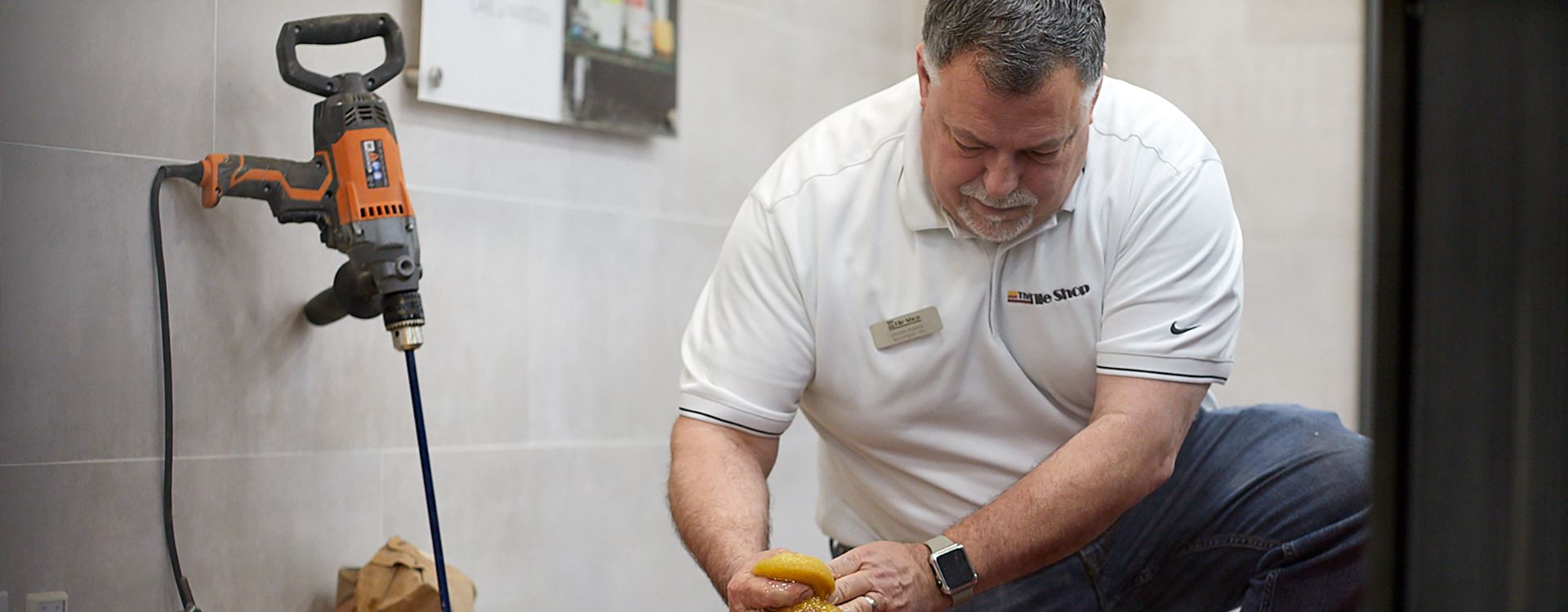
Sealing
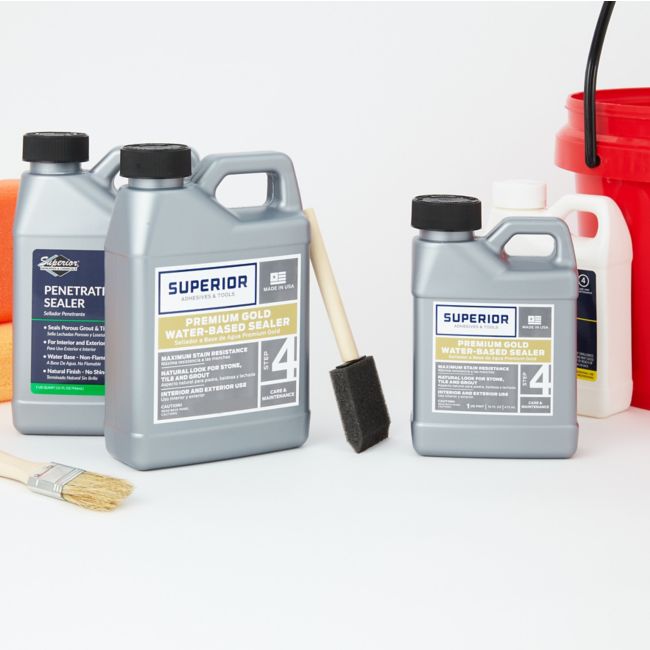
Sealing
In addition to protecting your tile or grout, sealers can also enhance their appearance. Give your installation a matte or shiny look and make sure it endures for the long run.
If your grout needs to be sealed, wait until it is fully cured to do so. Not all grouts need to be sealed, so check with your store associate to see if yours does. After sealing man-made tile, wipe excess sealer off with a dry rag to avoid a filmy residue.
Caulking
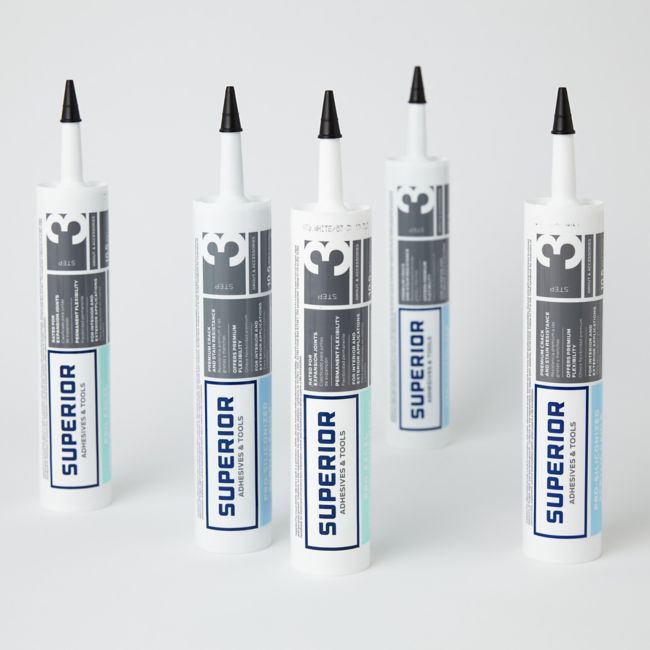
Caulking
Caulk is used to create a strong and waterproof bond between joints, whether between tiles, walls, counters or bathroom accessories.
You should caulk all 90° tile joints, whether they are between tile and wall, tile and counter or two walls. There are different types of caulk and application methods, so ask a store associate to recommend the best one for your project.
